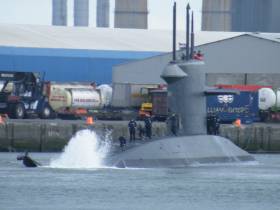Displaying items by tag: Dutch submarine
#navalvisitors - One of the world's most sophisticated submarines and an accompanying support ship of the Royal Netherlands Navy arrived in Dublin Port yesterday for a three day crew rest and recreation visit, writes Jehan Ashmore.
This is not the first Dutch Navy visitor to the capital this year as HNLMS Van Speijk, a Karel Doorman-class frigate was part of a three EU member state flotilla that called last month.
On this current visit, the first to arrive in Dublin Bay was submarine HNLMS Zeeleeuw, which has a 2,650 tonnes displacement (when submerged). In advance of entering the port a tug along with a small craft assisted the diesel-electric powered submarine while off the South Burford Bouy.
HNLMS Zeeleeuw was commissioned in 1990 however the submarine unintentionally became the first of the 'Walrus' class as HNLMS Walrus was delayed for a long period following a serious fire during construction. The 68m submarine was built by Rotterdamsche Droogdok Maatschappij.
The Walrus class instead of using a cross-shaped assembly of stern diving planes and rudders, they mount four combined rudders and diving planes in an "X" tail configuration (as more clearly demonstated in related story photo).
In total there are four submarines in the class and the quartet play a pivotal role in operations given these submarines have stealth designed technology. Deployments include overseas patrols in the Caribbean Sea with calls to Williamstad, the capital of the Netherlands Antilles.
The second visitor to Dublin is HNLMS Mercuur, which is the only surface vessel designed specifically to support the operations of the Dutch Navy. The 64m vessel was built by Damen Schelde Naval Shipbuilding and entered service in 1987.
Both naval visitors are berthed downriver in the main part of the port having been allocated berths at Ocean Pier within Alexandra Basin. They will not be open to public tours.
The pair are scheduled to depart on Friday with an hour appart of each other exiting the port in the morning.
Dutch Stealth Submarine Heads Upriver to Dock In Cork City-Centre
#NavyVisits - HNLMS Walrus which is one of the world's most sophisticated submarines arrived in Cork City yesterday for a courtesy visit this weekend, writes Jehan Ashmore.
The non-nuclear powered submarine is the leadship of the 'Walrus' class which was commissioned in 1992 for the Royal Netherlands Navy. In total there are four of the class and they are the only submarines of the Dutch Navy but play a pivotal role in operations.
HNLMS Walrus entered Cork Harbour in the afternoon. From within the expanse of the lower harbour, the 68m submarine navigated further upriver through Lough Mahon before making the final leg to the city's central quays.
According to the Dutch Embassy the visit to Cork is for the purpose of crew rest. Embarkation of the 50 submariners is from J.J. Horgan's Wharf on the north bank of the River Lee.
On this occasion, the Dutch Navy will not be on training exercises as previously conducted by a pait of fleetmates, albeit surface ships that visited Dublin last month. This involved a Landing Platform Dock (LPD) amphibious warfare ship and a frigate that took part in exercises off the east coast with the Irish Naval Service OPV L.É. William Butler Yeats.
The diesel-electric powered HNLMS Walrus has 4 torpedo tubes incorporated within the stealth designed submarine. Such technology is to make it more difficult to be detected by ships, aircraft or other submarines when deep under the ocean waves.
At 2,650 tonnes displacement (when submerged) HNLMS Walrus can remain under the water surface for long periods to enable missions. On overseas deployments, this can include patrolls in the Caribbean Sea with calls to Williamstad, the capital of Netherlands Antilles.
On this side of the Atlantic, the berth allocated in Cork for the submarine's visit as alluded above is where a sister HNLMS Dolfijn paid a call in 2016. That submarine did take part in exercises witht the Naval Service.
HNLMS Walrus will remain in port until Monday morning.
Submarine's Crew Call Before Departure on King's Day
#CrewRest – The Dutch embassy has contacted Afloat.ie to say the submarine that docked in Dublin Port was not in directly for repairs but for a crew rest and recreational call to the capital, writes Jehan Ashmore.
HNLMS Walrus had sailed into Dublin Bay on Sunday. The submarine dating to 1992 is the leadship of the 'Walrus' class quartet. They are regarded as one of the most advanced non-nuclear attack submarines in the world.
The 68m long HNLMS Walrus (ship's prefix refers to: His Netherlands Majesty's Ship) is to depart tomorrow on King's Day, where in the Netherlands the day celebrates King Willem Alexander’s official birthday. The annual celebration is marked with parties, street markets, concerts and special events for the royal family.
In neighbouring Belgium, a flotilla of navy vessels from that country are due to dock in Dublin Port on Friday.






























































